Synthesis and Characterization of New Composite Materials Based on Magnesium Phosphate Cement for Fluoride Retention
Abstract
1. Introduction
2. Experimental Procedure
3. Results and Discussion
3.1. Pure and H2O2 Cements
3.2. New Composites
3.3. Adsorption
3.3.1. Adsorption Study
3.3.2. Equilibrium Studies
3.3.3. Comparison with Other Used Adsorbents
4. Conclusions
Author Contributions
Funding
Institutional Review Board Statement
Informed Consent Statement
Data Availability Statement
Conflicts of Interest
References
- Chau, C.K.; Qiao, F.; Li, Z. Microstructure of magnesium potassium phosphate cement. Constr. Build. Mater. 2011, 25, 2911–2917. [Google Scholar] [CrossRef]
- Viani, A.; Sotiriadis, K.; Lanzafame, G.; Mancini, L. 3D microstructure of magnesium potassium phosphate ceramics from X-ray tomography: New insights into the reaction mechanisms. J. Mater. Sci. 2019, 54, 3748–3760. [Google Scholar] [CrossRef]
- Fang, C.; Zhang, T.; Jiang, R.; Ohtake, H. Phosphate enhance recovery from wastewater by mechanism analysis and optimization of struvite settleability in fluidized bed reactor. Sci. Rep. 2016, 6, 32215. [Google Scholar] [CrossRef] [PubMed]
- Li, Y.; Li, Y.; Shi, T.; Li, J. Experimental study on mechanical properties and fracture toughness of magnesium phosphate cement. Constr. Build. Mater. 2015, 96, 346–352. [Google Scholar] [CrossRef]
- Wu, H.; Xie, Z.; Zhang, L.; Lin, Z.; Wang, S.; Tang, W. A new magnesium phosphate cement based on renewable oyster shell powder: Flexural properties at different curing times. Materials 2021, 14, 5433. [Google Scholar] [CrossRef]
- Le Rouzic, M.; Chaussadent, T.; Stefan, L.; Saillio, M. On the influence of Mg/P ratio on the properties and durability of magnesium potassium phosphate cement pastes. Cem. Concr. Res. 2017, 96, 2741. [Google Scholar] [CrossRef]
- Cai, Q.; Turner, B.D.; Sheng, D.; Sloan, S. The kinetics of fluoride sorption by zeolite: Effects of cadmium, barium and manganese. J. Contam. Hydrol. 2015, 177, 136–147. [Google Scholar] [CrossRef]
- Shivaprasad, P.; Singh, P.; Saharan, K.; George, S. Synthesis of nano alumina for defluoridation of drinking Water. Nano-Struct. Nano-Objects 2018, 13, 109–120. [Google Scholar] [CrossRef]
- Lin, J.; Chen, Y.; Hong, X.; Huang, C.; Huang, C.P. The role of fluoroaluminate complexes on the adsorption of fluoride onto hydrous alumina in aqueous solutions. J. Colloid Interface Sci. 2020, 561, 275–286. [Google Scholar] [CrossRef]
- Zhao, Y.; Yan, Y.; Wu, Z.; Li, C.; Fan, R.; Feng, L.; Wang, W.; Chen, Q. A novel fluorescent covalent organic framework for the selective detection of fluoride ion. J. Mater. Sci. 2022, 57, 13425–13432. [Google Scholar] [CrossRef]
- He, J.; Yang, Y.; Wu, Z.; Xie, C.; Zhang, K.; Kong, L.; Liu, J. Review of fluoride removal from water environment by adsorption. J. Environ. Chem. Eng. 2020, 8, 104516. [Google Scholar] [CrossRef]
- Chen, N.; Zhang, Z.; Feng, C.; Sugiura, N.; Li, M.; Chen, R. Fluoride removal from water by granular ceramic adsorption. J. Colloid Interface Sci. 2010, 348, 579–584. [Google Scholar] [CrossRef] [PubMed]
- Borgohain, X.; Boruah, A.; Sarma, G.K.; Rashid, M.H. Rapid and extremely high adsorption performance of porous MgO nanostructures for fluoride removal from water. J. Mol. Liq. 2020, 305, 112799. [Google Scholar] [CrossRef]
- Sotiriadis, K.; Mácová, P.; Mazur, A.; Tolstoy, M.; Viani, A. A solid state NMR and in-situ infrared spectroscopy study on the setting reaction of magnesium sodiumphosphatecement. J. Non. Cryst. Solids 2018, 498, 49–59. [Google Scholar] [CrossRef]
- Souza, T.; Luz, A.; Pagliosa, P.; Pandolfelli, V.C. Mineralizing alumina–magnesia cement-bonded castables containing magnesium borates. Ceram. Int. 2015, 41, 11143–11152. [Google Scholar] [CrossRef]
- Stefov, V.; Šoptrajanov, B.; Spirovski, F.; Kuzmanovski, I.; Lutz, H.D.; Engelen, B. Infrared and Raman spectra of magnesium ammonium phosphate hexahydrate (struvite) and its isomorphous analogues. I. Spectra of protiated and partially deuterated magnesium potassium phosphate hexahydrate. J. Mol. Struct. 2004, 689, 1–10. [Google Scholar]
- Mourabet, M. Modelisation et Optimisation de L’adsorption des Ions Fluorure sur des Phosphates de Calcium. Ph.D. Thesis, Université Ibn-Tofail Faculté des Sciences, Kenitra, Morocco, 2014; pp. 18–25. [Google Scholar]
- Fletcher, H.R.; Smith, D.W. Sorption of fluoride onto alumina. In Proceedings of the ISRM International Symposium, Melbourne, VIC, Australia, 19–24 November 2000; pp. 229–246. [Google Scholar]
- Kra, D.O.; Atheba, G.; Kouadio, P.; Drogui, P.; Trokourey, A. Activated Carbon Based on Acacia Wood (Auriculeaformis, Côte d’Ivoire) and Application to the Environment through the Elimination of Pb2+ Ions in Industrial Effluents. J. Encapsulation Adsorpt. Sci. 2021, 11, 18–43. [Google Scholar] [CrossRef]
- Fan, X.; Parker, D.; Smith, M.D. Adsorption kinetics of fluoride on low cost materials. Water Res. 2003, 37, 4929–4937. [Google Scholar] [CrossRef]
- Nigussie, W.; Zewge, F.; Chandravanshi, B.S. Removal of excess fluoride from water using waste residue from alum manufacturing process. J. Hazard. Mater. 2007, 147, 954–963. [Google Scholar] [CrossRef]
- Pekar, M. Fluoride anion binding by natural lignite (South Moravian Deposit of Vienna Basin). Water Air Soil Pollut. 2009, 197, 303–312. [Google Scholar] [CrossRef]
- Rafique, A.; Awan, M.A.; Wasti, A.; Qazi, I.; Arshad, M. Removal of fluoride from drinking water using modified immobilized activated alumina. J. Chem. 2013, 2013, 386476. [Google Scholar] [CrossRef]
- Tripathy, S.S.; Raichur, A. Abatement of fluoride from water using manganese dioxide-coated activated alumina. J. Hazard. Mater. 2008, 153, 1043–1051. [Google Scholar] [CrossRef] [PubMed]
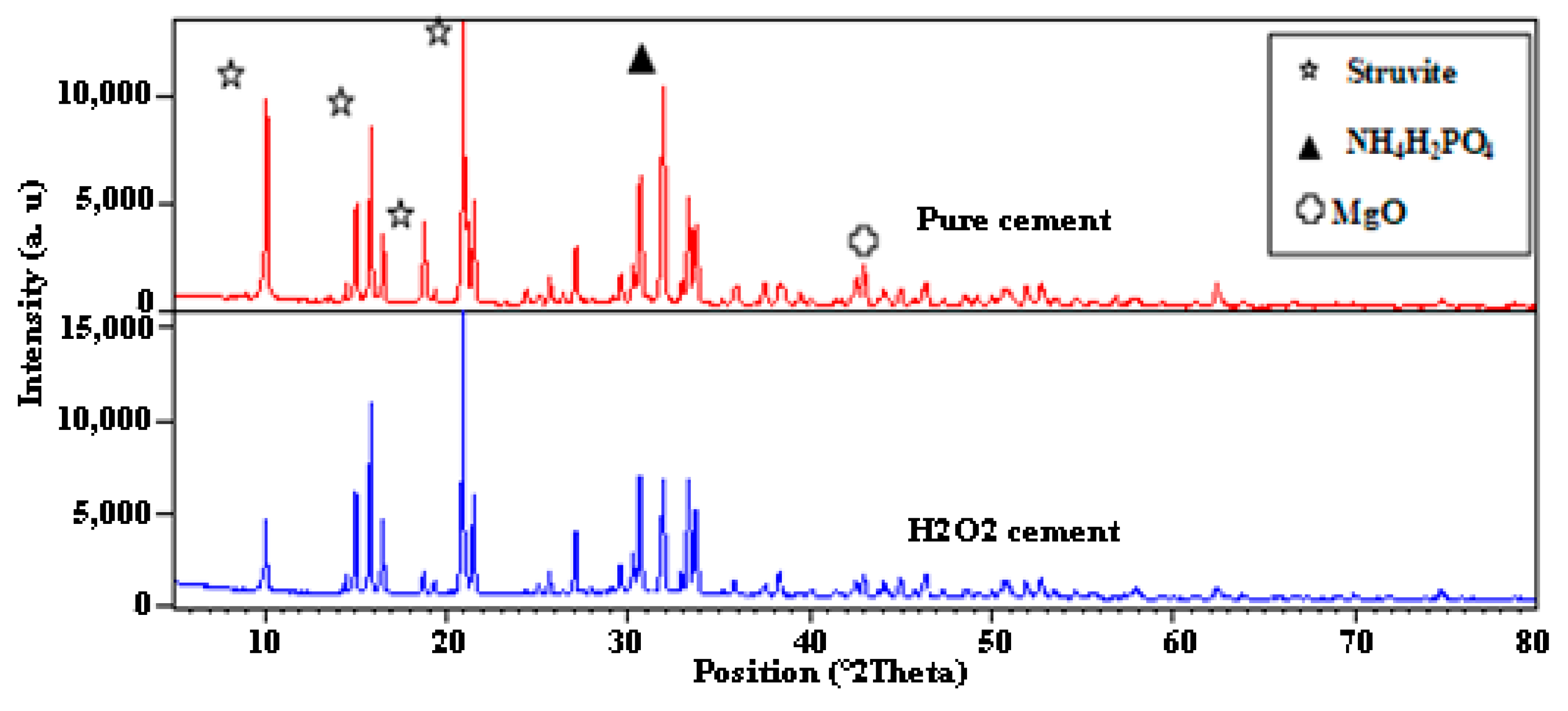
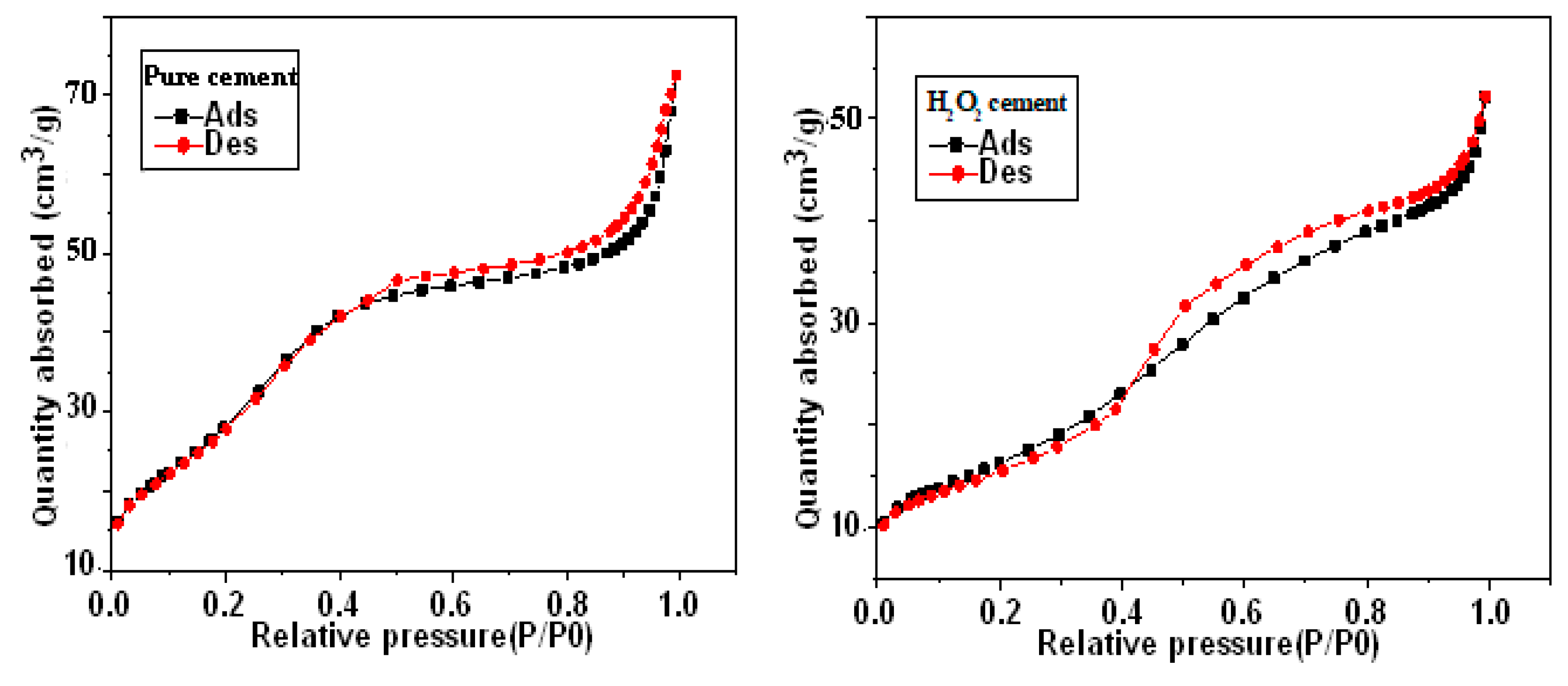
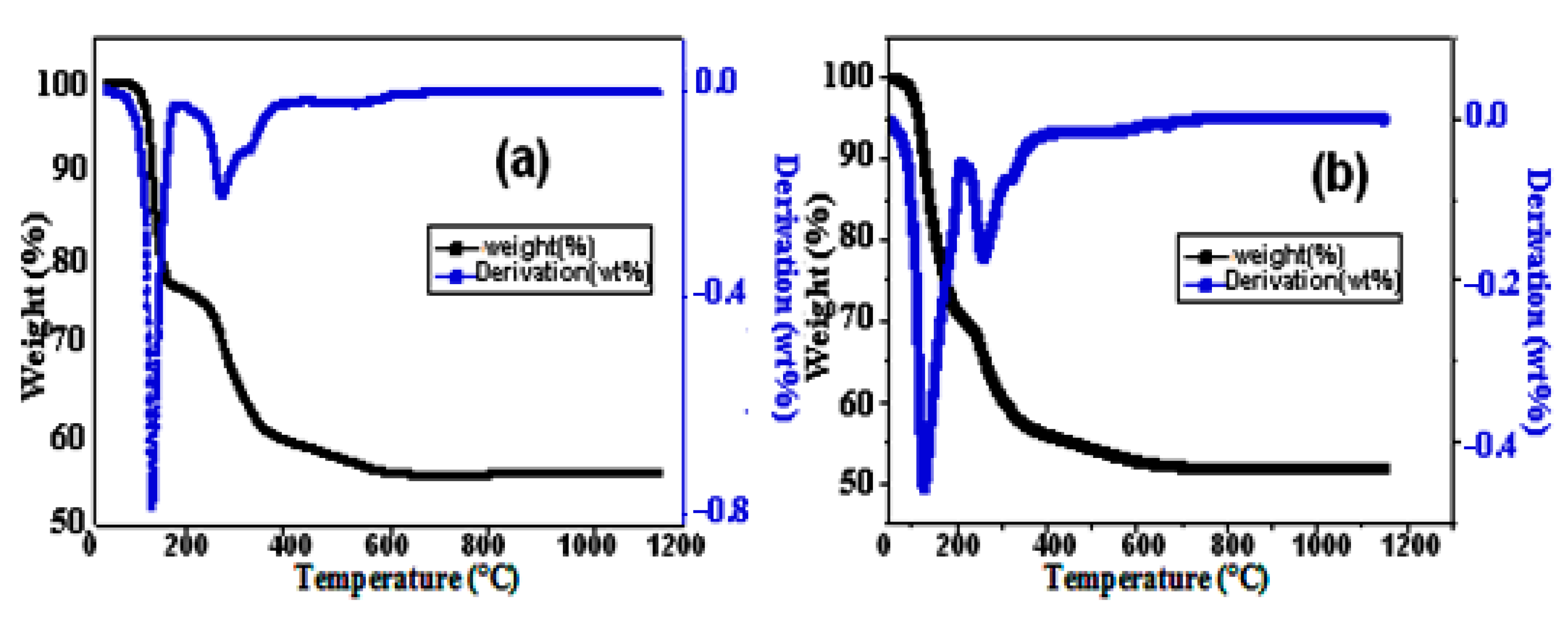
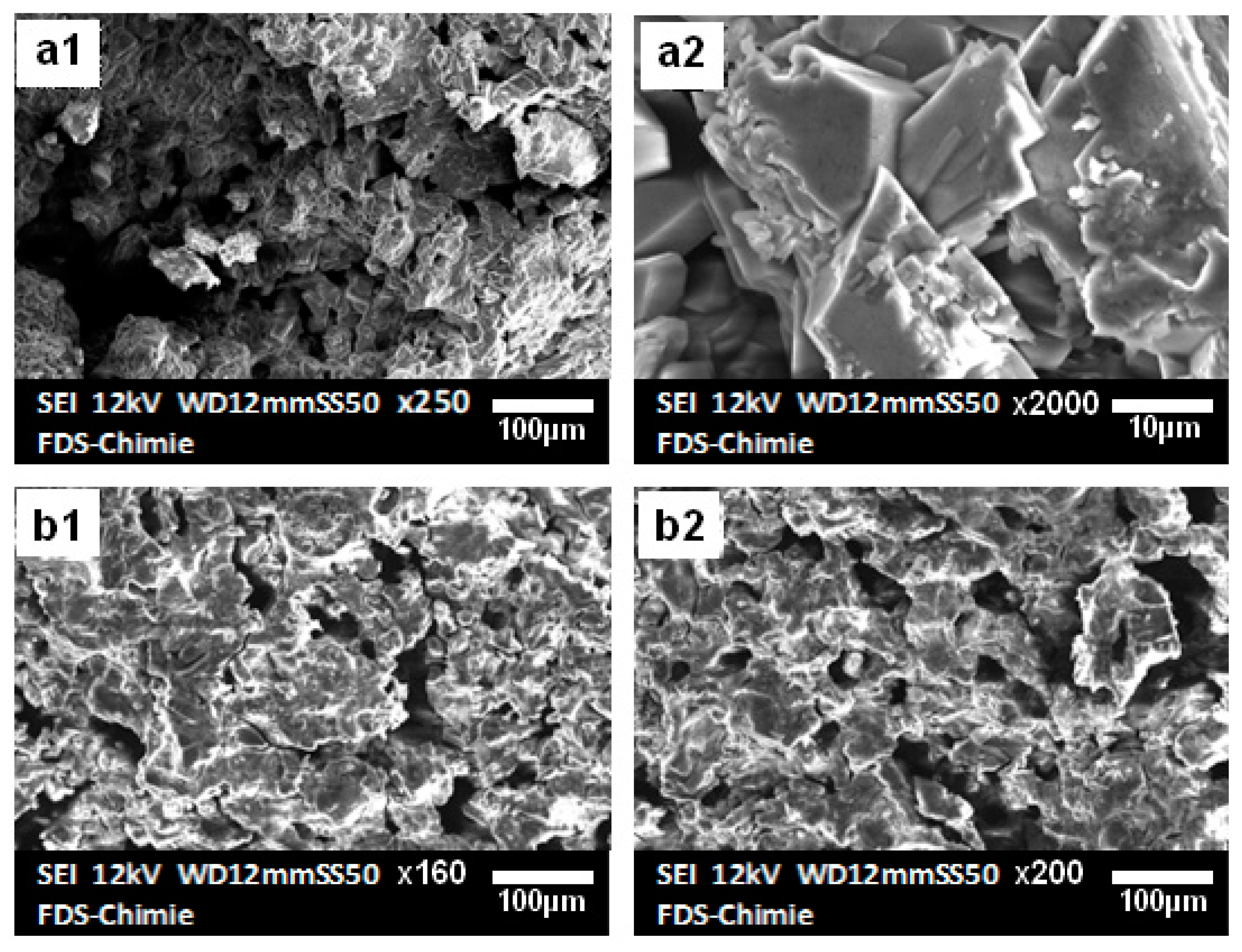

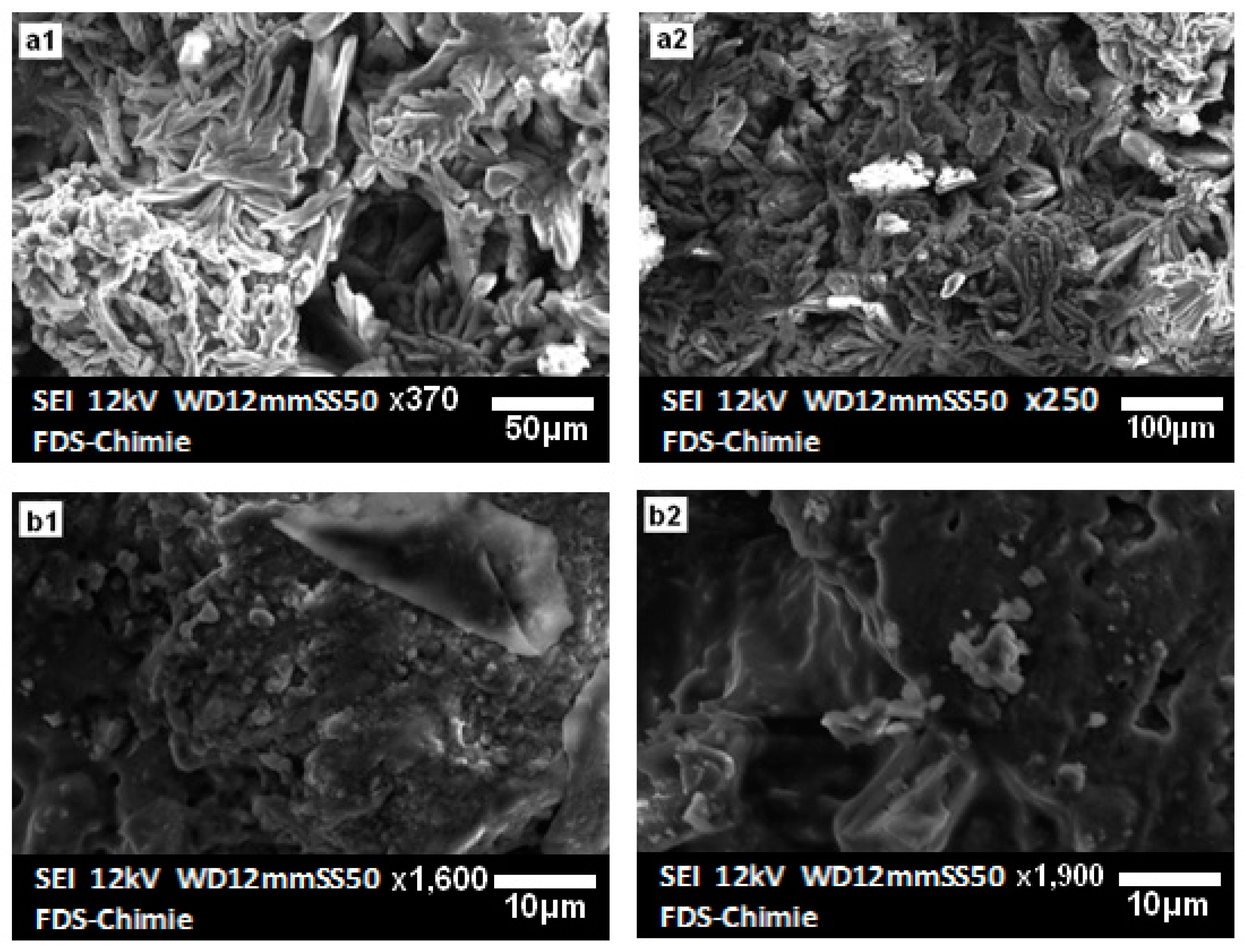

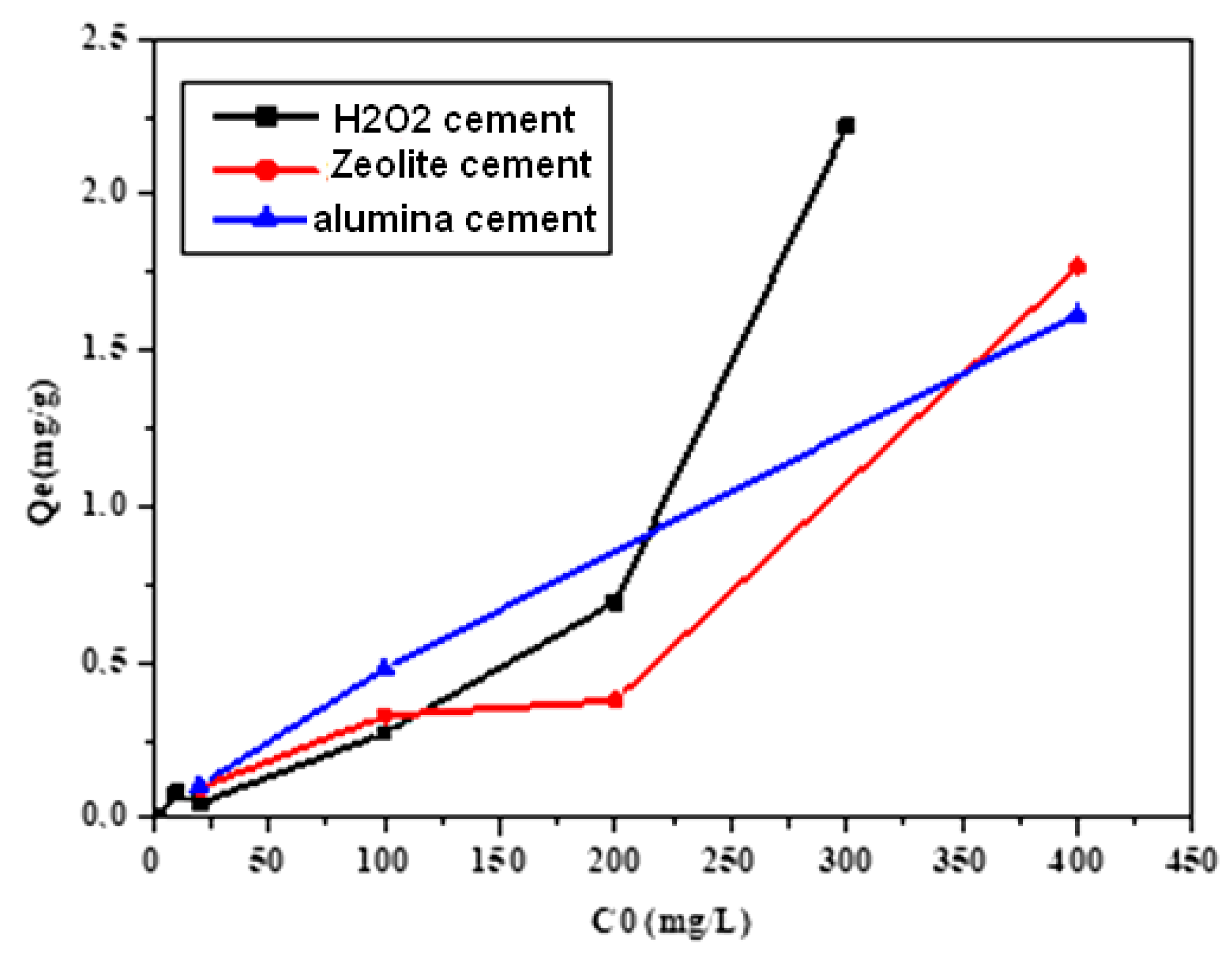
| MgO (g) | NH4H2PO4 (g) | Borax (g) | H2O (mL) | H2O2 (mL) | Al2O3 (g) | Zeolite (g) | |
|---|---|---|---|---|---|---|---|
| Pure cement | 1.0780 | 2.8720 | 0.3190 | 2 | - | - | - |
| H2O2 cement | 1.0560 | 2.8225 | 0.3270 | 2 | - | - | |
| Zeolite cement | 1.600 | 2.8240 | 0.3530 | 2 | - | 0.54 | |
| Alumina cement | 1.300 | 2.8710 | 0.3110 | 2 | 0.54 | - |
| Equation | H2O2 Cement | Zeolite Cement | Alumina Cement | |
|---|---|---|---|---|
| Langmuir | b = −4.322 L/g q0 = 0.231 mg/g Rl = 0.978 Kap = 0.118 R2 = 0.9736 | b = 0.9953 L/g q0 = 8.340 mg/g Rl = 0.064 Kap = 7.22 R2 = 0.9743 | b = −1.53 L/g q0 = 8.34 mg/g Rl = 0.064 Kap = 7.22 R2 = 0.850 | |
| Freundlich | 1/n = 5.712 Kf = 2.926 R2 = 0.9426 | 1/n = −4.99 Kf = 2.80 R2 = 0.881 | 1/n = −4.88 Kf = 2.80 R2 = 0.999 | |
| Temkin | A = 0.160 B = 0.373 R2 = 0.608 | A = 0.160 B = 0.373 R2 = 0.160 | A = 0.160 B = 0.373 R2 = 0.238 | |
| Dubinin–Radushkevich | qd = 0.418 B = −4.108 R2 = 0.590 | qd = 0.437 B = 1.53 R2 = 0.614 | qd = 0.43 B = 1.53 R2 = 0.849 |
| Adsorbent | Reference | Removal Capacity (mg/g) |
|---|---|---|
| Lignite | Pekar and al. (2009) [22] | 0.71 |
| Modified immobilized activated alumina | Rafique and al. (2012) [23] | 0.76 |
| Manganese dioxide-coated activated alumina | Tripathy and Raichur (2008) [24] | 1.22 |
| H2O2 cement | Present study | 2.21 |
| Zeolite cement | Present study | 1.76 |
| Alumina cement | Present study | 1.61 |
Disclaimer/Publisher’s Note: The statements, opinions and data contained in all publications are solely those of the individual author(s) and contributor(s) and not of MDPI and/or the editor(s). MDPI and/or the editor(s) disclaim responsibility for any injury to people or property resulting from any ideas, methods, instructions or products referred to in the content. |
© 2023 by the authors. Licensee MDPI, Basel, Switzerland. This article is an open access article distributed under the terms and conditions of the Creative Commons Attribution (CC BY) license (https://creativecommons.org/licenses/by/4.0/).
Share and Cite
Gharsallah, S.; Alsawi, A.; Hammami, B.; Khitouni, M.; Charnay, C.; Chemingui, M. Synthesis and Characterization of New Composite Materials Based on Magnesium Phosphate Cement for Fluoride Retention. Materials 2023, 16, 718. https://doi.org/10.3390/ma16020718
Gharsallah S, Alsawi A, Hammami B, Khitouni M, Charnay C, Chemingui M. Synthesis and Characterization of New Composite Materials Based on Magnesium Phosphate Cement for Fluoride Retention. Materials. 2023; 16(2):718. https://doi.org/10.3390/ma16020718
Chicago/Turabian StyleGharsallah, Sana, Abdulrahman Alsawi, Bechir Hammami, Mohamed Khitouni, Clarence Charnay, and Mahmoud Chemingui. 2023. "Synthesis and Characterization of New Composite Materials Based on Magnesium Phosphate Cement for Fluoride Retention" Materials 16, no. 2: 718. https://doi.org/10.3390/ma16020718
APA StyleGharsallah, S., Alsawi, A., Hammami, B., Khitouni, M., Charnay, C., & Chemingui, M. (2023). Synthesis and Characterization of New Composite Materials Based on Magnesium Phosphate Cement for Fluoride Retention. Materials, 16(2), 718. https://doi.org/10.3390/ma16020718






